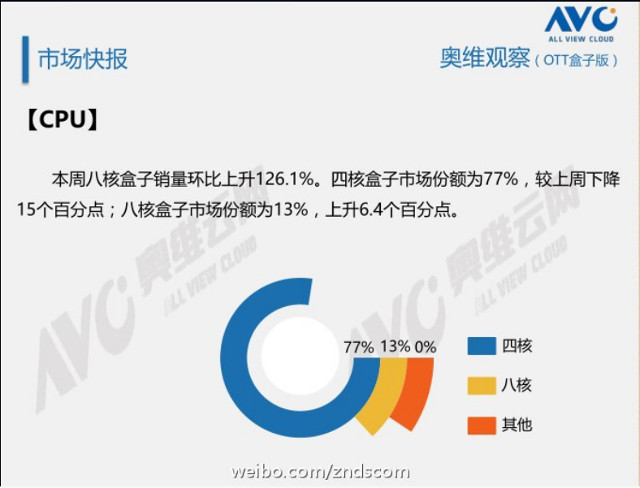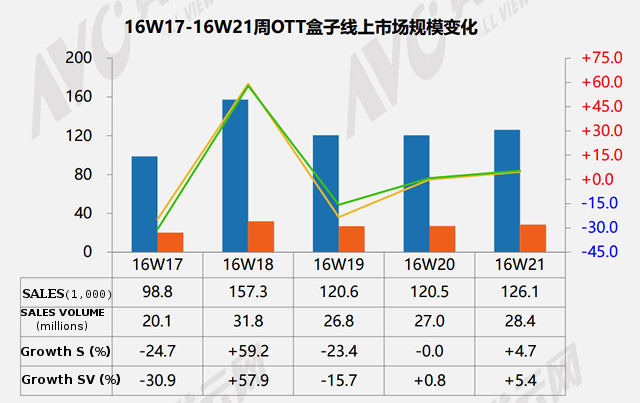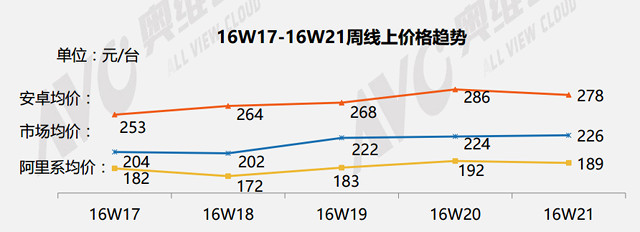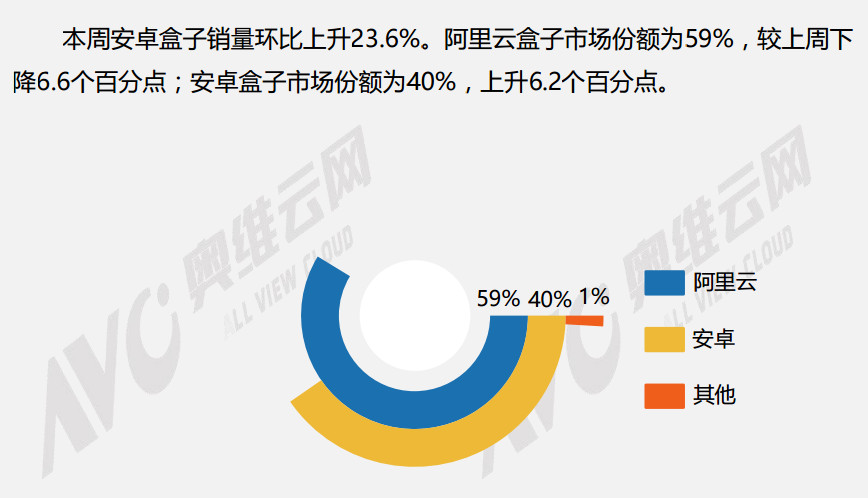I’ve recently seen a tweet from IloveRockchip twitter account about the weekly sales data, and market share of octa-core, quad-core, and other OTT TV boxes. The chart below shows 108,000 Android TV boxes were sold on the 37th week of 2016 (September 12 – 18), and that while quad core TV boxes still held 77% market share that week, octa-core sales grew by 108%.
 The downside is that the data is only for the Chinese market. But I still found interesting to investigate whether I could get more information. The research company, All View Cloud, will release weekly data to their paid customers, but a free sample report for Week 21 (16-22 May) can be downloaded from their website (N.B.: The link does not work in Firefox for me, but it does in Chrome).
The downside is that the data is only for the Chinese market. But I still found interesting to investigate whether I could get more information. The research company, All View Cloud, will release weekly data to their paid customers, but a free sample report for Week 21 (16-22 May) can be downloaded from their website (N.B.: The link does not work in Firefox for me, but it does in Chrome).
 “SALES” must be the quantity, roughly between 100,000 and 150,000 units sold per week, and if we extrapolate with the 5-week data above, that means about 6.5 million OTT TV boxes are sold each year in China, not that big a number considering China population. “SALES VOLUMES” is the amount in Chinese Yuan.
“SALES” must be the quantity, roughly between 100,000 and 150,000 units sold per week, and if we extrapolate with the 5-week data above, that means about 6.5 million OTT TV boxes are sold each year in China, not that big a number considering China population. “SALES VOLUMES” is the amount in Chinese Yuan.
The next chart shows the average price of OTT TV boxes (blue line) is about 220 RMB ($33).
 The red line correspond to the average price for Android TV boxes, and the yellow line the average price for Aliyun OS (aka YunOS) TV boxes.
The red line correspond to the average price for Android TV boxes, and the yellow line the average price for Aliyun OS (aka YunOS) TV boxes.
Back in May, the quad core TV boxes enjoyed an 88% market share against 12% for octa-core TV boxes, and 4% for others, and at the time. Aliyun OS () had the biggest market share with 59%, against 30% for Android (), and 1% for others. Android was however growing at 23.6 %, while Aliyun OS TV share decreased by 6.6% against the previous week.
The report goes on with the most popular videos streaming services with (wasu.com.cn) by far the most popular with 64% market share, followed by CNTV, , CIBN and GITV.
They also have a list of the top 20 TV boxes in China based on online usage, and the top 5 have dominated by three companies:
- Tmall M13
- Tmall TMB300A
- Xiaomi Mi Box Pro (MDZ-09-AA)
- Xiaomi Mi Box Mini
- Diyomate X5
The brands and models are completely different from the ones popular overseas, and only Xiaomi models are relatively easy to buy (but not to use) outside of China. I wrote about older Diyomate TV Box models in the past (2012) based on Telechips processor, so the company has been around for a while.

Jean-Luc started CNX Software in 2010 as a part-time endeavor, before quitting his job as a software engineering manager, and starting to write daily news, and reviews full time later in 2011.
Support CNX Software! Donate via cryptocurrencies, become a Patron on Patreon, or purchase goods on Amazon or Aliexpress






What’s the connection to Rockchip?
@GanjaBear
Nothing. They just used one slide to promote their quad and octa core processors.
Some of those boxes on the list are Rockchip-based then?
@GanjaBear
Maybe, but I have not checked since it was not the point of this post.
@cnxsoft
Two thoughts pop to mind, isn’t Xiaomi box on sale or going on sale in America ( hope it comes to UK too, Android box market needs the competition )
Second though is volumes of sales, if only Android TV boxes would adopt a standardised GPIO. Would not add that much cost but would drive down single board computer costs, just by volume of sales lowering costs..
@Theguyuk
The Xiaomi Box for sale in the US is a different model.
The development board market is even smaller than the TV boxes one. So while a standardized GPIO header is cool, I’m not convinced it would help with sales.
The Top 5 isn’t. Its all cheap Amlogic S905 and S802 😮
Thanks for checking that out! I’d have been surprised to have completely missed the RK revolution 😉